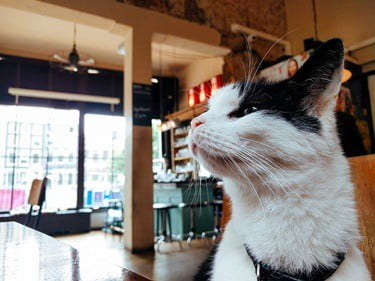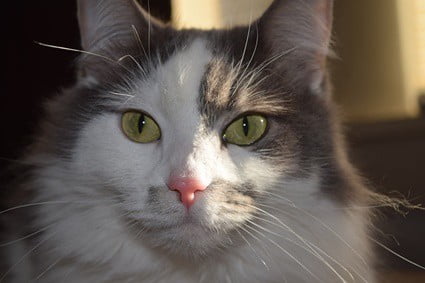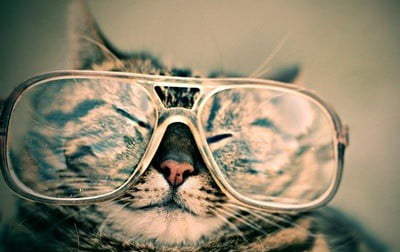Cats are highly attuned to their surroundings, giving the impression that they don’t have bad eyesight or visual problems. However, cats can’t focus clearly on anything that’s under a foot away. Also, some cats will develop eye problems that stop them from being able to see well. So, do cats ever need glasses or contact lenses?
Vet ophthalmologists don’t use eyeglasses to correct feline short and long-sightedness. Even if glasses or cat goggles were widely available, a cat would likely refuse to wear them for too long. However, vets have developed contact lenses that help the eye heal after corneal damage.
As with all of the feline senses, cats’ eyesight does deteriorate with age. So, cats aged 9 and older may develop nuclear sclerosis. This manifests as a cloudy vision, but the wearing of glasses or treatment isn’t required. Cats can also experience problems that obscure their vision, including trauma, injuries, cataracts, and infections.
Basic Components of A Cat’s Eye
Feline eyes have the following essential components:
- Cornea: A clear dome that protects the eye and lets in light.
- Pupil: The black center of the eye lets in light and focuses it on the retina so that the cat can see.
- Iris: A pigmented muscular membrane surrounds the pupil and is located in front of the lens and ciliary body and behind the cornea. It contracts or expands to let in light.
- Lens: Transparent, flexible tissue located behind the iris and the pupil. It adjusts its shape to focus light rays.
- Retina: A membrane that lines the back of the eye and is highly sensitive to light. It receives light impulses from the retina and sends them to the brain.
- Optic nerve: Located in the back of the eye, the optic nerve transfers visual information from the retina to the brain using electrical impulses.
According to Semantic Scholar, cats rely on their vision to navigate, hunt, interact with other cats, and avoid dangerous situations. While cats don’t see the finer details the same way we do, they have an extra, reflective layer in the back of their eye behind the retina called a tapetum.
The tapetum lucidum reflects incoming light and bounces it back off the cones, making the most use of the light. This gives a cat its excellent nocturnal vision and is responsible for the mirror-like reflection we see in a cat’s eyes when a bright light is shone onto them.
Cats can also dilate their pupils widely, which maximizes the amount of light that enters the eye when it’s dark. This is the main reason why a cat’s night-time vision is 6 times better than that of humans.
Cat Vision vs. Human Vision
Scientists have many theories as to how well they can see. Some have theorized that cats can only see in black and white, while some studies were incomplete and didn’t render any clear results. However, current research seems to agree that there are many clear differences between feline and human vision.
Visual Field and Peripheral Vision
The frontal part of a cat’s visual field is covered by both eyes, which results in binocular vision. This allows cats to see at a greater depth of 200 degrees, including a 140° frontal binocular field and two lateral monocular fields of 30° each. In comparison, humans have a visual field of 180 degrees.
Cats also have better peripheral vision than humans. Their wider visual field also allows them to see more clearly at the edges of their eyes. A human’s visual field is quite narrow in comparison.
Day vs. Night-Time
Cats have better night vision. They’re more active at dusk and dawn, so they need to see in the dark effectively. For this to happen, cats have 6 to 8 more rods in their eyes than we do. These are sensitive to low light.
In comparison, the human retina has 10 times more light receptions than cats do. These are better in situations with higher light levels and provide 12 times better motion detection in bright lights.
Color Range
Cones are responsible for the perception of color. Humans have 3 different types, which allow us to see red, green, and blue and the related combinations. However, because a human retina features 10 times more cone cells than a cat’s, we can perceive a broader spectrum of colors.
Because cats have fewer cones, they perceive a smaller range of colors, including blue, gray, and yellow. So, while a cat can’t see as many colors as humans do, the colors are not restricted to black and white as often theorized. They’re merely less vibrant than what a human can see.
Near or Far-Sighted
Cats aren’t either, but they can only see clearly less than 20 feet away because of their large eyes. But this is where their whiskers come in, as they can swing forward to feel what cats cannot see.
This alerts them to danger or stops them from entering spaces that are too small. Humans can see clearly as far as 100 to 200 feet away.

Feline Vision Problems
A cat’s eyesight can help it see inside and out. Unfortunately, this leaves the eyes vulnerable to injury and other diseases that can affect and impair vision. Blindness and vision loss aren’t restricted to old age but can result from various health issues. These are the most common:
Cataracts
A cataract increases the opacity of the eye’s lens, which causes it to develop cloudy patches that impairs vision. When a cat develops a cataract, the lens becomes cloudy or opaque and prevents light from properly reaching the retina. Severe cataracts can cause significant eyesight loss in cats.
Feline cataracts are commonly caused by eye trauma, viral infection, or poor nutrition. Cats with cataracts may develop a reluctance to climb stairs or jump onto high surfaces. They may suddenly become clumsy and bump into things that appear right in front of their eyes.
Eye drops may help the situation. But in cases where cataracts cause a significant problem, surgery to remove them may be required. This is only viable if the animal is healthy enough to survive sedation. Or, if there’s an underlying cause, treating that first may lessen the impact of the cataract.
Strabismus And Astigmatism
Strabismus is when the eyes are fixed in the wrong position or cross over. This causes depth perception issues and other vision problems. The most common cause is a genetic defect of the eyes, but an injury to the eye or brain, feline leukemia virus, and cancer can also be the causes.
An astigmatism is a form of blurry vision caused by a refractive error of the eye. The Siamese seems to be the originator of the problem, and any breed where the Siamese influenced the breeding stock can be prone to these conditions.
All cats with strabismus have astigmatism, but not all cats with astigmatism have strabismus. Both can occur at any time in a cat’s life and will cause significant vision problems. A cat may bump into objects and have difficulty walking as it can’t see in front of itself correctly.
Retinal Damage
Damage to the retina, including retinal detachment, is usually caused by high blood pressure due to hyperthyroidism, diabetes, or kidney disease. Retinal detachment is where the retina becomes separated from its underlying tissue, which is usually a result of leakage or an oversupply of fluid between the two layers.
Retinal damage usually results in partial or full vision loss. This can be a slow process, but the result is often blindness.
Corneal Ulcers
The cornea is the transparent part of the eye that covers the iris and the pupil. It can be seen as a clear windowpane on the eyeball’s surface and lets light into the eye, allowing a cat to see. Damage to the cornea will almost certainly cause vision problems.
A corneal ulcer, also known as ulcerative keratitis, is a painful condition where the cornea suffers from a deep erosion, leading to severe damage. The most common cause of a corneal ulcer is trauma. This could be from a cat coming into contact with a hardened surface or sharp object, which causes a painful laceration. Other causes include:
- Viral infections
- Disease
- Tear deficiency
- Foreign matter in the eye
- Chemical burns
A cat with a corneal ulcer will likely squint, keep its eye closed, or paw at the head or eye. The affected eye might appear red and inflamed, and there may be discharge coming from it. Sensitivity to light or film over the eyes are noticeable signs of an ulcer.
Depending on the severity of the condition, surgical treatment might be needed to remove the ulcer. Otherwise, antibiotics and anti-inflammatories can reduce the infection and help with the pain. The cat’s activity will need to be reduced to give the eye a chance to heal. In the worst cases, there may be long-term eyesight damage.
How To Tell If Your Cat Has Vision Problems
Cats can’t tell us when there’s something wrong, so it’s essential to monitor how they behave in the event of health problems. When it comes to a cat’s eyesight, its physical behavior is often a good indicator that something is wrong. If you notice your cat exhibiting the following actions, vision issues might be a cause:
Shock or Startle
If a cat is easily shocked or startled, it might not see what it is in front of it. If you quietly enter a room and your cat doesn’t even know you’re there, it’s probably because it cannot see you. This is a sign that the cat has deteriorating eyesight.
Hesitation
A cat that frequently seems hesitant to jump or walk around could be showing signs of sight loss. This is usually coupled with the cat bumping into things or displaying clumsy tendencies. A crouched position indicates that the cat is uneasy and wants to stay close to the ground. This isn’t normal behavior.
These signs are particularly alarming in curious or active cats. Any sudden or noticeable changes in behavior should be addressed, and its eyesight checked.
Squinting
Squinting is a sign that a cat is either having trouble seeing or that light rays are causing discomfort. A cat might squint to see better, or it might not be able to open its eyes altogether. Trauma or physical injury to the eye are the most likely causes.
Disorientation
Vision problems are likely to cause frustration, confusion, and general disorientation. A cat might express this frustration through vocalizations, like increased meowing and yowling, to get its owner’s attention. This is a cry for help and shouldn’t be ignored.
Changes to The Eye
Discoloration of the eye, excessive wateriness, and discharge signify something physically wrong with your cat’s eyes. Physical trauma might be to blame, as well as diseases or infections. Never wait for the eyes to get better on their own.
Are There Glasses for Cats?
Cat glasses do exist for cats with bad eyesight. It’s rare to find a cat wearing glasses, and in most cases, glasses are put on cats purely for fun.
The reality is, though cats experience the same sight problems as humans, they don’t really need glasses because it is unlikely that they’ll be near or far-sighted.
Cats do not have the correct nose structure to keep glasses on their faces, especially with flat-faced cat breeds with short noses. Glasses won’t aid a cat’s eyesight, and few cats will be happy to wear them.

Contact Lenses for Cats
Contact lenses are available to cats, but not with vision problems. Vets often use therapeutic soft contact lenses on cats with damaged corneas.
The contact lenses allow the eye to heal by protecting it from discomfort caused by the movement of the eyelids. This prevents painful and expensive surgery. Less commonly, lenses can be used to hide eye damage for cosmetic reasons.
If a cat needs treatment for a cataract, its damaged lens will be replaced by an artificial lens to allow them to see better. This is permanent and can’t be placed in and out like the kind humans wear.
Doggles for Cats
Doggles are a brand of eye protection goggles designed and manufactured to fit a dog’s head. The range is mostly fashion-led, but prescription glasses are available for dogs with eyesight problems with a prescription from a vet ophthalmologist.
Though the range doesn’t include eyewear for cats, cat goggles can be worn by cats that travel on motorcycles, bikes, or other fast-moving vehicles that could irritate the cat’s eyes. However, a cat road tripping with its owners is rare. A cat wearing goggles is even more unusual. Goggles are not available to help with a feline’s eyesight – they’re more a current trend fad.
So, while it might seem plausible for prescription glasses to be available to cats, they don’t exist. Instead, any visible signs of infection or damage to the eye should be closely monitored. Similarly, any sudden changes in behavior, including disorientation or clumsiness, could signify that a cat struggles with its eyesight.


I do wonder if there’s any way to heighten the visual acuity from distances caused by the tapetum lucidum. Are they bound to only have a range of up to 20ft of clear vision?